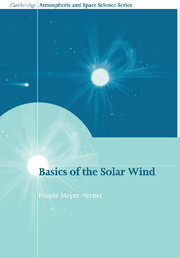Book contents
- Frontmatter
- Contents
- Preface
- 1 The wind from the Sun: an introduction
- 2 Tool kit for space plasma physics
- 3 Anatomy of the Sun
- 4 The outer solar atmosphere
- 5 How does the solar wind blow?
- 6 Structure and perturbations
- 7 Bodies in the wind: dust, asteroids, planets and comets
- 8 The solar wind in the Universe
- Appendix
- Index
5 - How does the solar wind blow?
Published online by Cambridge University Press: 22 October 2009
- Frontmatter
- Contents
- Preface
- 1 The wind from the Sun: an introduction
- 2 Tool kit for space plasma physics
- 3 Anatomy of the Sun
- 4 The outer solar atmosphere
- 5 How does the solar wind blow?
- 6 Structure and perturbations
- 7 Bodies in the wind: dust, asteroids, planets and comets
- 8 The solar wind in the Universe
- Appendix
- Index
Summary
…such were the facts accumulated by the Scientific Researcher. And now, what deep, far-reaching Theory was he to construct from them?
Lewis Carroll, Sylvie and BrunoWe have seen that the solar atmosphere is so hot, out to so large a distance, that it cannot be held back by the Sun's gravity nor confined by the pressure of the interstellar medium. The interstellar medium therefore sucks it, somewhat as a vacuum cleaner – a nice illustration of Aristotle's horror vacui doctrine, but a pack of puzzles for the modern physicist.
There are essentially two ways of addressing the problem. One way is to view the solar atmosphere as a fluid, flowing out under the action of the pressure imbalance between the Sun and the interstellar medium. Historically, this was the first theory of the solar wind, and even now it remains the one on which most theoretical attempts are based.
The fluid description, however, requires the medium to be close to local thermodynamic equilibrium, which does not hold in the outer solar atmosphere. As we already noted, the basic difficulty is that the fluid picture requires an assumption on heat transport. However, the flow is far from adiabatic, and indeed we shall see that if it were adiabatic, there would be no solar wind. Therefore, the heat conductivity plays an important role, but its classical expression (see Section 2.3) is not valid because there are not enough collisions to ensure an approximate equilibrium.
- Type
- Chapter
- Information
- Basics of the Solar Wind , pp. 223 - 290Publisher: Cambridge University PressPrint publication year: 2007



